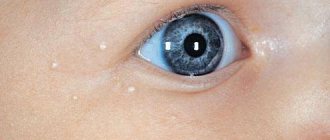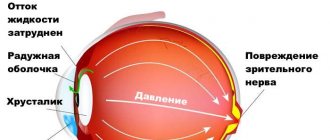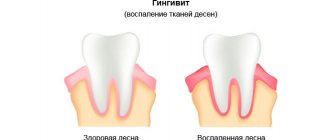Causes of congestion
To establish the causes of nasal congestion, it is necessary to understand what preceded this condition. The following factors matter:
- contacts with an infected person;
- exposure to allergens;
- hypothermia;
- prolonged inhalation of dry air;
- features of the diet.
To assess the general condition, you should measure the child’s temperature, analyze activity and appetite.
ARVI
This condition is considered the most common cause of problems. In the first 2-3 days of the illness, the baby develops nasal congestion. The pathology has not yet fully manifested itself, but inflammation of the mucous membranes has already occurred.
Allergic rhinitis
This condition appears at certain times of the year - most often in the spring. However, there are other allergens that can be active throughout the year. These include wool, food, and house dust. To determine the causes of the disorder, the child should be shown to an allergist.
Overgrowth of adenoids
Under the influence of various factors, these elements may increase in a child. The mucus that is released begins to flow down the back wall of the nasopharynx. At the same time, the nose gets blocked at night, the child is forced to sleep with his mouth open. He may wheeze. If such a clinical picture appears, you should definitely consult a doctor.
Polyps
When these benign formations appear in the baby’s nose, there is chronic congestion. It can be temporarily eliminated with drops. However, such drugs cannot completely solve the problem. In addition to congestion, there is general weakness, impaired sense of smell, and frequent ENT pathologies.
Often, polyps provoke compression of blood vessels, which leads to disruption of the blood supply to tissues. As a result, swelling occurs. When the auditory tubes are damaged, hearing and speech disorders occur. Such signs are very dangerous for young children. Often the formation of polyps provokes a change in bite.
Sinusitis
With this disorder, mucus does not flow from the nasal sinuses. In this case, a headache is observed. Nasal congestion does not go away for quite a long time, which only aggravates the condition of the little patient. In such a situation, you should immediately consult a doctor. To cope with sinusitis, it is often necessary to use antibiotics.
Deviated nasal septum
This disorder may be associated with physiological processes. It has different course options. However, it is very difficult to immediately detect such changes.
An article on the topic - signs and methods of treating a deviated nasal septum.
Hormonal disorders
Changes in hormone balance usually occur during adolescence. This condition can also cause congestion, in which there is no runny nose.
Impact of external factors
In large cities there is a large emission of gases and dust. As a result, children experience nasal congestion. As a result, it is very difficult to breathe. This can lead to dangerous pathologies.
Foreign object
In some cases, foreign objects enter the nostrils. These can be small buttons, beads, pieces of food. Sometimes foreign objects enter the respiratory system through vomiting. As a result, sneezing and watery eyes occur. After some time, these symptoms disappear and nasal congestion remains.
An article on the topic - how to restore the nasal mucosa - how to moisturize it.
Why does chronic rhinitis appear?
What should I do if my child has a constant runny nose? First of all, you need to decide where this problem comes from. The reasons why a child often has a clogged nose can be different. It is quite difficult to identify the source of the disease.
Let us highlight the main reasons why chronic rhinitis appears in a child:
- The baby's body was subjected to severe hypothermia. Remember if your child’s hands or feet were frozen. Or maybe he was breathing cold air or was in a draft.
- Hereditary or acquired after injury curvature of the nasal septum.
- Hormonal changes as a consequence of improper functioning or insufficient functioning of the glands.
- Complications after surgery.
- Regular contact with allergens.
- Dry air in the room where your child lives.
- Wrong diet.
At first glance, the reasons may seem harmless, however, if the disease sets in, it will not be easy to cure a persistent runny nose. Therefore, you should pay special attention to how your child spends his time, whether he is overcooled, and whether he is dressed warmly.
In addition, improve the quality of housing. Buy a humidifier and regularly ventilate the children's room.
What to do if your child has difficulty breathing
If nasal congestion occurs, it is imperative to take appropriate measures. The famous children's doctor Komarovsky recommends systematically ventilating the room, as well as monitoring humidity and temperature parameters.
In addition, following these rules will help improve your baby’s condition:
- Drink a lot - this will help make nasal discharge more liquid;
- walk more in the fresh air;
- rinse your nose with saline solution;
- put healthy oils in your nose - peach or olive.
If after 5 days nasal breathing has not been restored, you should definitely consult a specialist.
Common Causes

In order to eliminate the manifestation of such an unpleasant symptom, you need to understand and find out why the baby has a stuffy nose. It is worth noting that both external irritants and infectious diseases can provoke nasal congestion.
- If the immune system is not fully functioning, it will not be able to repel the attack of viruses. The development of viral diseases can be triggered by hypothermia of the body, which is why the peak occurrence of colds occurs in the cold seasons.
- Difficulty breathing can be caused by inflammation of the adenoids. During colds, they increase in volume and close the nasal passage.
- In infancy, a runny nose can be a specific reaction of the body to teething.
- Children prone to allergic reactions are at high risk of developing allergic rhinitis. Difficulty in breathing often manifests itself along with sneezing, lacrimation, and mucous discharge from the nose.
The most common causes of prolonged nasal congestion include:
- Dry indoor air. The children's room must be regularly ventilated, and in winter it is also necessary to artificially humidify the air in the room.
- Acute viral rhinitis. Often accompanied by a runny nose.
- Herpetic lesions of the nasal cavity.
- Bacterial rhinitis.
- Pathological processes associated with the proliferation of fungi of the genus Candida inside the nasal cavity.
- Inflammation of the sinuses.
- Rhinitis of allergic nature.
- Vasomotor rhinitis.
Currently, allergic rhinitis is a common problem. Children of all ages are increasingly faced with this pathology. Many experts attribute this to the fact that the child comes into contact with household chemicals and medications literally from the first days of life. It is interesting to know that a predisposition to developing allergies is often formed in artificially raised children. Rhinitis of this type often appears in the spring months, because at this time trees are actively blooming, the pollen of which penetrates the respiratory tract. It is worth noting that patients with allergic rhinitis have a certain predisposition to the development of bronchial asthma.
Traditional Treatments
To choose the right therapy, you need to analyze other symptoms of the pathology.
The baby may experience itching, watery eyes, and a burning sensation. In this case, congestion may be a manifestation of an untreated respiratory disorder. If breathing problems occur due to a cold, special solutions and vasoconstrictors are used to eliminate the discomfort. These include galazolin, tizin, etc. Such products can only be used as prescribed by a doctor.
Experts do not recommend using such drugs for more than 3 days . Longer use may lead to addiction. As a consequence, there is a threat of atrophic changes in the structure of the mucous membrane.
At home, it is permissible to use the following recommendations from specialists:
- Hot foot baths. Thanks to this procedure, it will be possible to achieve a temporary result and make it easier for the baby to breathe by eliminating swelling.
- Low concentration saline solution. This product is used for washing several times a day. Sea salt is most suitable for this purpose.
- Massage. An excellent remedy for nasal congestion is massaging the pad of the hand. It is present on both hands in the thumb area.
It is important to ensure that the child’s nasal congestion does not become chronic. If any signs appear, you should immediately contact an otolaryngologist.
When adenoids grow, the use of medications and special drops does not give the desired results. In this situation, the specialist prescribes physiotherapy. In difficult cases, surgery is used. If polyps form in the nasal cavity, surgery is also indicated.
We recommend what to do if one nostril is blocked.
Symptoms
It is worth paying special attention to your child and noticing the slightest changes in his health. This is necessary in order to recognize chronic rhinitis in children.
What initially does not cause even a fraction of concern can later transform into problems. It is worth remembering that the symptoms in children are quite vivid, so it will not be difficult to pay attention to them.
What symptoms indicate that a child has a persistent runny nose:
- The child often sneezes, even in those moments when there are no irritants nearby.
- Crusts of pus appear in the nose. They are dry and green. There may be complaints of breathing problems due to these small growths. They block the passages in the nasal cavity. If you get rid of them, new ones will appear over time.
- A runny nose and nasal congestion are another sign of chronic rhinitis. The nose is constantly clogged and frequent snot of a liquid consistency bothers me. It is worth noting that if a child constantly has snot, then this is the most striking symptom.
- Often the child begins to snore at night and may have trouble sleeping due to nasal congestion.
- Often the baby is bothered by a wet cough with regular attacks.
- The voice becomes nasal.
- The baby develops a dry throat and nasal cavity, he complains of thirst and constant snot, which brings him a lot of discomfort.
As you can see, chronic runny nose in children has clear and characteristic symptoms. The disease is very difficult to confuse with other diseases. However, there is still a need to visit a specialist in order to exclude the possibility of complicating factors.
Useful folk remedies
To cope with nasal congestion, you can use the following remedies:
- Aloe . The juice is squeezed out of the leaves of this plant and mixed with water in equal proportions. For nasal congestion in children, the drug is instilled three times a day. Thanks to this, it is possible to improve the condition and stop the inflammatory process.
- Beet . You need to squeeze the juice from this vegetable and mix it in equal parts with water. Drop into the nose three times a day. If a burning sensation occurs, you need to dilute the product even more. You can also use boiled beet juice. It doesn't have that sharpness.
- Egg . It needs to be boiled and applied to the nose. It is necessary to keep the product until it cools.
- Sea salt . Take 1 tablespoon of this product and mix with 1 liter of water. Use the resulting rinse solution.
- Chamomile . This product perfectly restores breathing. Chamomile decoction is perfect for rinsing the nose. You can soak a cotton swab in the product and place it in your nose for 20 minutes. To prepare the infusion, take 1 large spoon of flowers and add a glass of cold water. Infuse the product for 8 hours. However, the nose should only be instilled with a warm solution. It is recommended to strain the product before use.
- Onion . Take a medium onion and squeeze the juice out of half. Mix in equal parts with water and apply to the nose up to 5 times a day. It is prohibited to use the product in its pure form, as it can cause a burn.
ethnoscience
Traditional medicine for congestion will help restore the ability to breathe through the nose. Despite the development of pharmacology, a large number of people seek help from healers. This is due to the fact that medicines from unrecognized healers have a gentle effect on the human body.
Drops
It is recommended to use the juice of herbs and vegetables as nasal drops.
- Aloe drops will help you cope with colds, relieve nasal congestion and eliminate nasal drainage. Freshly squeezed juice should be diluted in half with water and instilled 1 drop into each nostril 3 times a day. Drops help stop the inflammatory process and speed up the healing process.
- Beetroot juice can be used when a child has a constantly stuffy nose. Before use, it also needs to be diluted with water 1:1. However, such a composition can provoke burning and itching.
Inhalations
In the early stages of the disease, inhalations help relieve congestion. Sometimes literally 2-3 procedures are enough to completely eliminate unpleasant manifestations.
- Pour 1 cup of boiling water into a deep plate, add 2-3 drops of fir oil and ½ tsp. soda The baby should inhale the vapors, covered with a towel, for a minute. Parents should not leave the baby alone during inhalation.
For better results, this manipulation can be performed 2-3 times a day. In the spring and winter, inhalations are used for preventive purposes.
Nasal rinsing
Irrigation of the nasal cavity with a solution of salt water is one of the most effective measures to help relieve congestion.
- To prepare the solution you will need ½ tsp. table salt and 1 glass of hot water. When preparing a solution for rinsing the nose in adults, the proportions can be increased.
The child's nose can be washed with a syringe without a needle or syringe.
If the child’s nose is not breathing, but there is no snot, such treatment will help restore normal breathing. The saline solution has a positive effect on the mucous membranes, moisturizes them, and washes out particles of pathogenic microorganisms from the nasal cavity. An undoubted advantage is that the solution prepared at home can be used to treat congestion in allergy sufferers.
Massage
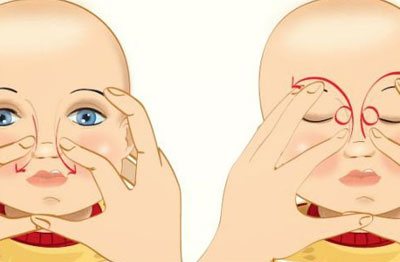
Massage in the nasal area with difficulty breathing has a positive effect on the patient’s condition and improves blood circulation.
- In case of prolonged congestion, light massage movements need to knead the wings of the nose and the area of the bridge of the nose. You should also pay attention to the frontal area and the area near the tragus of the ear.
Such manipulation can be performed provided there is no temperature. During the massage, the baby should not experience any unpleasant sensations. The procedure can be performed up to 3 times a day.
Warming up
If nasal congestion is not accompanied by nasal drainage, increased body temperature, or headaches, warming can be used to restore breathing. It should be remembered that before using the technique it is better to consult with your doctor.
- Boiled chicken eggs are used as a heating pad. Two eggs are applied to the wings of the nose for 5 minutes. Before you apply a heating pad to your baby’s nose, you need to check its temperature on yourself. The child should not feel discomfort.
Before attempting to relieve nasal congestion, every effort should be made to identify the causes. Treatment at home may not give positive results, but will only worsen the course of the disease.
Contraindications
In order not to harm the baby, parents should take into account that it is not recommended to use it for treating children. So, without consulting a doctor, it is prohibited to use the following:
- Antibacterial drugs. Before using medications, you should consult your doctor. Improper antibiotic therapy can lead to the spread of infection and disruption of the microflora.
- Drops with a vasoconstrictor effect. If you violate the instructions for use of such products, the risk of increased dryness of the mucous membranes increases. This will cause the development of medicinal rhinitis.
- Rinse the nasal cavities under pressure. You should not use a syringe or syringe for this purpose. Do not inhale too much fluid through one nasal opening. In this case, there is a risk of infected solution getting into the ear. This can lead to otitis media.
- Oil inhalations.
- Herbal infusions. The use of such products for rinsing the nasal passages increases the risk of developing allergies.
Article on the topic - what to do if it is difficult to breathe.
How to cure a clogged nose in a child
Treatment of nasal congestion in children
Every mother should know how to get rid of nasal congestion. It is more difficult to treat a small child than an adult. For example, a tiny person cannot blow his nose on his own.
By the way! The child only needs to blow his nose in cases where it is really required. When you blow your nose, the blood vessels enlarge, making breathing even more difficult.
Of course, therapy should be started at the first symptoms. But it must be borne in mind that morning nasal congestion without additional symptoms is not considered a pathology.
Consulting a doctor will never be superfluous. We remind you! Self-medication can be dangerous!
It is best to leave medications as a last resort, and start with various procedures: rinsing, inhalation, warming, etc.
Washing with saline solution is considered absolutely harmless. You can prepare it yourself at home, buy saline solution or a special spray at the pharmacy.
Salty liquid washes out mucus very well. To do this, you need to bury it in your nose every 2-3 hours (if saline or saline solution is used).
Older children are allowed to rinse their nasal passages with a regular syringe. Need to:
- Remove the needle.
- Fill the syringe with salt water.
- Place the baby's head on its side.
- Pour the solution into the upper nostril. Invite the baby to open his mouth.
- Turn the child over to the other side and repeat the procedure.
If your baby is prone to allergies, you should not forget about antihistamines.
Mothers who decide to treat their child with vasoconstrictor drugs should carefully study the instructions. It must be remembered that such drugs are addictive and can lead to irreversible consequences.
Important! Vasoconstrictor medications are allowed to be used for 3–5 days. This is the maximum period.
Experts do not recommend such products for children under one year of age.
Inhalations are very helpful in treating a runny nose. A time-tested method is to inhale the vapors of boiled potatoes. Those who have free funds can purchase an inhaler. For inhalations, essential oils and decoctions of medicinal herbs are used: chamomile, calendula, eucalyptus, mint, menthol, tea tree and many others.
During a runny nose, the baby should be given as much warm drink as possible, teas, broths, and newborns should often be offered breastfeeding.
Every mother is upset if her baby gets sick. Therefore, as soon as the child’s nose is blocked, a cough or fever appears, the parent begins treatment. It should be noted that he is doing the right thing. But in some cases, you should not ignore the doctor’s recommendations, because incorrect therapy leads to complications, and self-medication can be fatal.
How can a child clear snot from his nose? — Doctor Komarovsky:
♦ Category: Children's diseases.
Possible complications
If a child has nasal congestion for a long time, there is a risk of dangerous complications. These include the following:
- Impaired sense of smell, hearing and speech.
- Hypotrophy. It develops if there is weight loss in a newborn baby due to insufficient nutrition.
- Impaired physical condition. This may be the result of prolonged hypoxia. An insufficient amount of oxygen in the internal organs leads to disruption of their formation and progression of dysfunction.
- Inflammation of the lower part of the respiratory system. This is caused by inhaling cold, unpurified air through the mouth.
- Impaired intellectual capabilities. This creates difficulties with the perception of school material.
The risk of complications is quite high in children with complex autoimmune pathologies and congenital immunodeficiency.
Nasal congestion is a fairly serious condition that can cause negative consequences. To avoid complications, you need to start treatment for this condition on time, and for this you should consult a doctor.
A detailed look at all the causes of nasal congestion without a runny nose, as well as treatment options
Injuries
Children are walking poltergeists, so it is not surprising that they can get hurt or injured. Also, older children may quarrel and then fight. If this happens, you will notice swelling of the child's facial area, bruising, and nasal congestion.
Recommended reading: Sodium sulfacyl in a child’s nose.
What to do?
If an injury happened before your eyes or you witnessed a fight, you need to apply cold ice to your nose as soon as possible. Also, do not place the child in a horizontal position - he should be in an upright position. You can lubricate the nasal cavity with a healing gel, for example, “Rescuer”, but this should only be done if there is no heavy bleeding and the touch is painful. If there is bleeding, especially if you don’t put the baby down, it will only get worse. Take your child to the emergency room if you think the nasal septum is moving too freely.
Non-standard anatomy
It often happens that under the influence of some external or genetic factors, the child’s nasal cavity takes on an irregular shape.
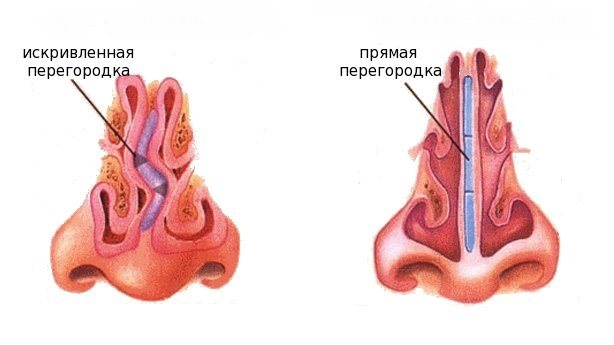
Congenital anomalies of nasal cartilage are noticeable immediately after the birth of a child. Such a baby does not breathe through his nose and is unlikely to ever be able to do so without intervention.
Growth abnormalities of the skull bones also occur. In this case, we are talking about the formation of the bone base of the nasal cavity. Such defects most often make themselves felt during puberty.
Deformation of the bone base of the nose can also occur due to injury. Young children are especially susceptible to this, because the bone base of the nose has not yet been formed.
“For the nose” for children: instructions for use
Drops and spray of the drug are intended for intranasal administration:
- Spray 0.1% (from 6 years). If a child has a stuffy nose and no snot, it is necessary to inject the product up to 4 times a day. To perform the procedure correctly, it is recommended to hold the bottle of medicine vertically so that its nozzle is directed upward. Carefully insert the spray nozzle into the nostril and press sharply, then remove the nozzle without releasing it. This will allow the solution to be evenly distributed on the nasal mucosa. Repeat the procedure with the other sinus.
- Drops 0.05% (up to 6 years). The drug is administered into each nasal cavity, 1-2 drops using a pipette. Regularity of use - no more than 3 times a day. Use to relieve congestion for no more than 5 days.
Vasoconstrictor drops should be considered as an addition to the main treatment. They help alleviate the child's condition and improve air flow through the nose. But this group of drugs is not able to cope with the underlying cause.
If a child’s nose is clogged and drops do not help, you can help the baby with home rinses.
Treatment of nasal congestion
When visiting a doctor, prepare the following information:
- Where did the baby walk before congestion appeared, what kind of food did he eat;
- Who was he in contact with? There is always a high probability of catching a virus in public places, especially in warm rooms;
- What diseases did he have before?
- What medications did you take, as side effects may suddenly arise from them;
- How long has he had these symptoms?
If a baby has a stuffy nose, then the first thing you need to do is create an atmosphere favorable for breathing in his room. The approximate ideal humidity should be at 50-60%, the room should be ventilated frequently.
It is imperative to determine the true cause of congestion, but in any case, decongestants can be used. Drops will perfectly help eliminate symptoms.
In a situation where the child has a stuffy nose but no snot, the safest option would be to use folk remedies. These include nasal drips of aloe juice diluted with boiled water or carrot or beet juice.
When a baby’s nose is stuffy, you can also drip oil solutions, which will have a wonderful effect on strengthening and moisturizing the mucous membrane. For allergic rhinitis, antihistamines should be used.
3 ways to clean a newborn’s nose:



